- Details
- Written by: Elmazen
- Category: Flags of Countries of the World
- Hits: 749
Flag of Brazil
Flag of Brazil, Currency, Population, Tourist Places, Culture, Borders
Exploring Brazil: Facts, Culture, and Must-Visit Destinations
Brazil, the largest country in South America, is a land of vibrant culture, natural wonders, and rich history.
Let’s dive into some fascinating facts about this incredible nation.
--------------------------
Flag of Brazil
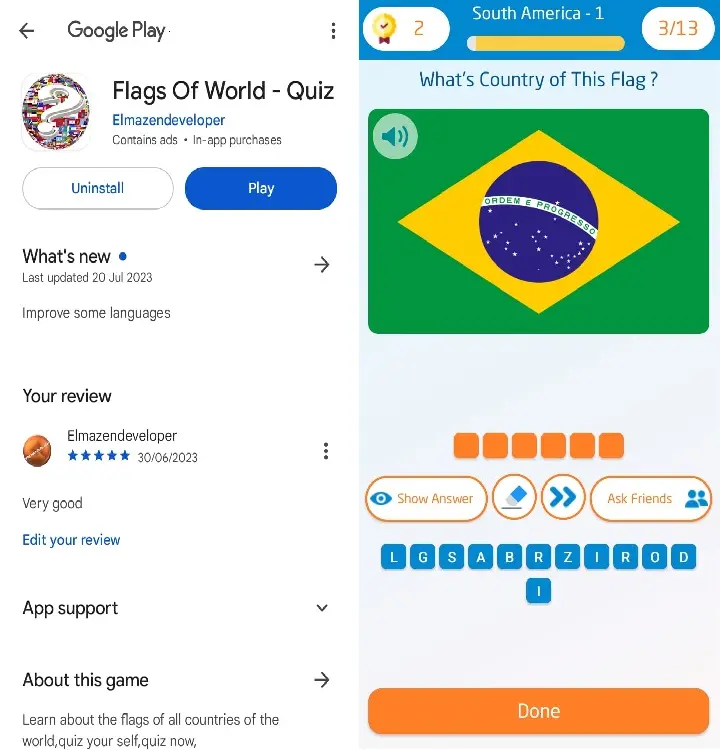
Download the application  Flags Of World - Quiz ,
Flags Of World - Quiz ,
And test your knowledge with Flags of World ,
1. Population of Brazil
As of November 2024, Brazil is home to approximately **212,3 million people**, making it the most populous country in South America and the sixth most populous globally.
Its diverse population includes a mix of ethnicities and cultures, creating a unique and dynamic society.
------------------------
2. The Meaning Behind Brazil's Flag
The Brazilian flag is a symbol of the country’s identity and natural wealth.
It features:
Green Field: Represents the lush forests and vegetation, especially the Amazon Rainforest.
Yellow Rhombus: Symbolizes the country’s rich mineral resources, including gold.
Blue Circle with Stars: Depicts the night sky over Rio de Janeiro as it appeared on November 15, 1889, the day Brazil became a republic.
The stars represent the 26 states and the Federal District.
Motto "Ordem e Progresso": Translates to "Order and Progress," reflecting the nation's aspirations.
---------------------------
3. Currency of Brazil
The official currency of Brazil is the **Brazilian Real (BRL)**, abbreviated as "R$".
It is further divided into 100 centavos.
The Real has been in use since 1994, replacing the Cruzeiro.
-------------------------
Flag of Brazil

Download the application  Flags Of World - Quiz ,
Flags Of World - Quiz ,
And test your knowledge with Flags of World ,
4. Borders of Brazil
Brazil shares borders with almost all South American countries except Chile and Ecuador.
Its neighbors include:
North: Venezuela, Guyana, Suriname,
West: Colombia, Peru, Bolivia,
Southwest: Paraguay, Argentina,
South: Uruguay
---------------------------
5. Culture of Brazil
Brazilian culture is a vibrant mix of **indigenous, African, and European influences**.
Key cultural elements include:
Music and Dance: Samba, bossa nova, and forró are iconic music styles.
Capoeira, a martial art combined with dance, is another cultural hallmark.
Festivals: The Carnival of Brazil, celebrated before Lent, is the country’s most famous festival, featuring parades, music, and costumes.
Cuisine: Brazilian cuisine blends indigenous and immigrant influences.
Popular dishes include feijoada (a black bean and meat stew), pão de queijo (cheese bread), and brigadeiro (chocolate truffles).
Religion: Brazil is predominantly Catholic, but there is also a significant presence of Protestantism and Afro-Brazilian religions like Candomblé.
-----------------------
6. Best Places to Visit in Brazil
Brazil offers breathtaking natural landscapes, historic towns, and modern cities.
Some must-visit destinations include:
1. Rio de Janeiro
Famous for the Christ the Redeemer statue, Sugarloaf Mountain, and Copacabana Beach.
2. Amazon Rainforest
Explore the world’s largest tropical rainforest through Manaus, the gateway city.
3. Iguaçu Falls
A stunning series of waterfalls on the border with Argentina, offering spectacular views and hiking trails.
4. Salvador
Known for its Afro-Brazilian culture, architecture, and vibrant music scene.
5. Pantanal
A vast wetland teeming with wildlife, ideal for eco-tourism and wildlife spotting.
6. São Paulo
A bustling metropolis with excellent museums, diverse cuisine, and a thriving arts scene.
7. Florianópolis
Famous for its beautiful beaches, ideal for surfing and relaxation.
-----------------------
Conclusion
Brazil is a country of immense beauty and cultural richness.
Whether you're drawn by its natural wonders, dynamic cities, or colorful traditions, Brazil offers a wealth of experiences that captivate travelers and locals alike.
Flag of Brazil

Download the application  Flags Of World - Quiz ,
Flags Of World - Quiz ,
And test your knowledge with Flags of World ,
- Details
- Written by: Elmazen
- Category: Flags of Countries of the World
- Hits: 737
Flag of Bolivia
Flag of Bolivia, Currency, Population, Tourist Places, Culture, Borders
Exploring Bolivia: A Land of Rich Culture and Stunning Landscapes
Bolivia, a country nestled in the heart of South America, offers a unique blend of history, culture, and natural wonders.
From its vibrant traditions to breathtaking landscapes, Bolivia is a treasure trove of experiences.
Here’s everything you need to know about this fascinating country:
-----------------------------
Flag of Bolivia
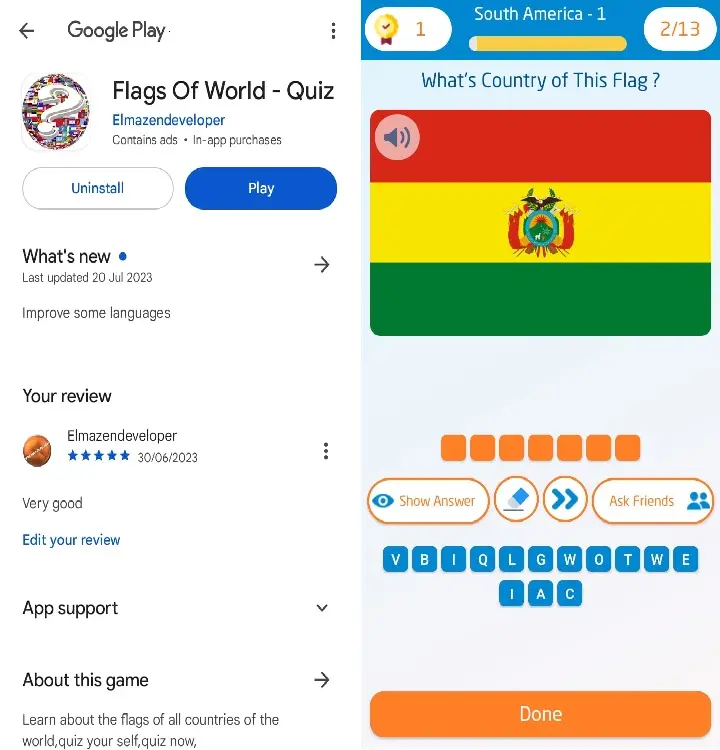
Download the application  Flags Of World - Quiz ,
Flags Of World - Quiz ,
And test your knowledge with Flags of World ,
1. Population of Bolivia
As of November 2024, Bolivia has an population of approximately **12,47 million people**.
The country is characterized by its diverse demographics, with a significant portion of the population comprising Indigenous peoples, including Quechua, Aymara, and other groups, alongside mestizo and European descendants.
----------------------------
2. Bolivia's Flag and Its Meaning
The national flag of Bolivia consists of three horizontal stripes:
Red: Represents the bravery and sacrifice of Bolivian soldiers.
Yellow: Symbolizes the country's rich mineral resources.
Green: Reflects Bolivia's fertile lands and the hope for a prosperous future.
At the center of the flag, the Bolivian coat of arms is sometimes displayed, highlighting important national symbols such as Mount Potosí and the llama, which is a key animal in Bolivian culture.
---------------------------------
3. Bolivia's Currency
The official currency of Bolivia is the **Boliviano (BOB)**.
It is further divided into 100 centavos.
The Boliviano reflects the country's economic history and remains a stable form of currency for trade and commerce.
--------------------------------
Flag of Bolivia

Download the application  Flags Of World - Quiz ,
Flags Of World - Quiz ,
And test your knowledge with Flags of World ,
4. Bolivia's Borders
Bolivia is a **landlocked country** in South America and shares its borders with:
Brazil: to the north and east.
Paraguay: and Argentina to the south.
Chile: to the southwest.
Peru: to the west.
Despite being landlocked, Bolivia retains access to ports through agreements with neighboring countries.
--------------------------------
5. Culture of Bolivia
Bolivia's culture is a vibrant tapestry woven from Indigenous, Spanish, and modern influences.
Key aspects of Bolivian culture include:
Traditional Music and Dance: The music often features instruments like the charango and panpipes, while dances like the *Diablada* and *Morenada* are prominent during festivals.
Cuisine: Bolivian food reflects its diverse geography, with dishes like *salteñas* (savory pastries), *silpancho* (breaded meat served with rice and potatoes), and *pique macho* (spicy meat dish).
Festivals: The *Carnaval de Oruro* is a UNESCO-recognized celebration that showcases colorful costumes, traditional dances, and religious rituals.
Languages: Spanish is the official language, but many Indigenous languages, such as Quechua and Aymara, are widely spoken.
-----------------------
6. Best Places to Visit in Bolivia
Bolivia is home to some of the most extraordinary destinations in the world.
Here are the must-visit places:
1. Salar de Uyuni: The largest salt flat in the world, offering surreal landscapes and mirror-like reflections during the rainy season.
2. La Paz: The world’s highest capital city, known for its dramatic mountain backdrop and vibrant markets like the Witches' Market.
3. Lake Titicaca: The highest navigable lake in the world, shared with Peru, featuring the sacred Isla del Sol (Island of the Sun).
4. Madidi National Park: A biodiversity hotspot in the Amazon basin, perfect for wildlife enthusiasts.
5. Potosí: A historical city famed for its colonial silver mines and UNESCO-listed architecture.
6. Tiwanaku: An ancient archaeological site that offers insights into pre-Columbian civilizations.
7. Sucre: Bolivia's constitutional capital, known for its charming architecture and historical significance.
-------------------------------
Conclusion
Bolivia is a country of contrasts, where ancient traditions blend seamlessly with modern life, and natural wonders captivate the imagination.
Whether you're exploring the salt flats of Uyuni, immersing yourself in Indigenous culture, or marveling at its architectural heritage, Bolivia promises an unforgettable experience.
So pack your bags and get ready to discover the heart of South America!
Flag of Bolivia

Download the application  Flags Of World - Quiz ,
Flags Of World - Quiz ,
And test your knowledge with Flags of World ,
- Details
- Written by: Elmazen
- Category: Flags of Countries of the World
- Hits: 721
Flag of Argentina
Flag of Argentina, Currency, Population, Tourist Places, Culture, Borders
Discovering Argentina: Key Facts and Wonders
Argentina, located in the southern part of South America, is a country renowned for its vibrant culture, stunning landscapes, and rich history.
Here's a comprehensive overview of Argentina, covering its population, flag, currency, borders, culture, and top destinations.
---------------
Flag of Argentina
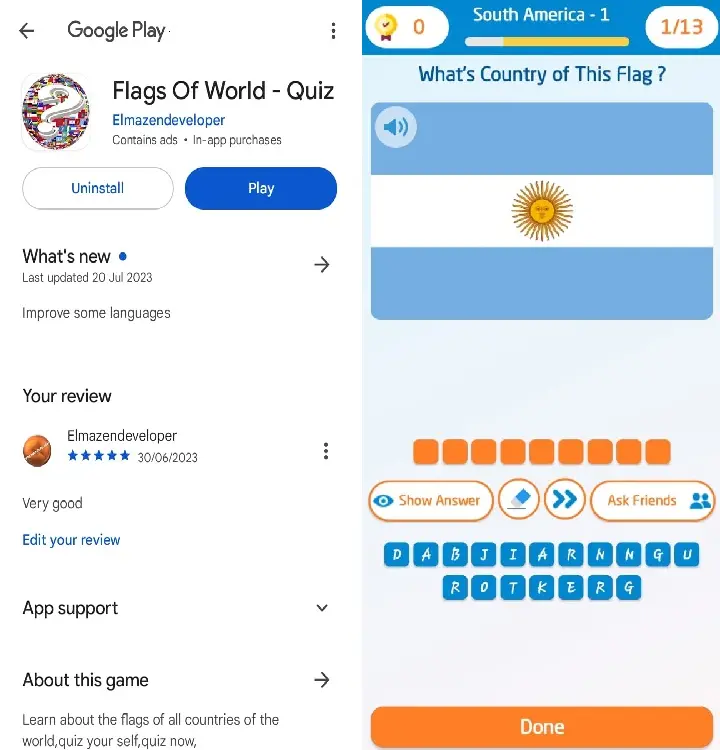
Download the application  Flags Of World - Quiz ,
Flags Of World - Quiz ,
And test your knowledge with Flags of World ,
1. Population of Argentina
As of November 2024, Argentina has an estimated population of approximately 45.75 million people.
The population is diverse, with influences from indigenous peoples, European immigrants (mainly from Spain and Italy), and other global communities.
------------------------
2. The Meaning Behind Argentina’s Flag
Argentina's flag is a symbol of unity and pride.
It consists of three horizontal bands: light blue, white, and light blue.
At its center is the Sun of May, a golden sun with a human face.
Light Blue and White: These colors are believed to represent the clear skies and snow-capped Andes Mountains, though some also associate them with the Virgin Mary.
Sun of May: The sun symbolizes freedom and independence.
It traces back to the May Revolution of 1810, which marked the beginning of Argentina's journey toward independence from Spain.
---------------------
3. Currency of Argentina
The official currency of Argentina is the Argentine Peso (ARS).
The peso is divided into 100 centavos. Like many currencies, the value of the Argentine peso fluctuates due to economic conditions.
-------------------------
Flag of Argentina

Download the application  Flags Of World - Quiz ,
Flags Of World - Quiz ,
And test your knowledge with Flags of World ,
4. Borders of Argentina
Argentina shares borders with several countries in South America:
Chile: to the west (separated by the Andes Mountains),
Bolivia: and Paraguay to the north,
Brazil: and Uruguay to the northeast,
To the east, Argentina is bordered by the Atlantic Ocean, providing access to beautiful coastal areas.
-----------------------------
5. The Culture of Argentina
Argentine culture is a fusion of indigenous traditions and European influences.
Here are some key cultural highlights:
Tango: Argentina is the birthplace of tango, a passionate and dramatic dance that originated in Buenos Aires in the late 19th century.
Cuisine: Argentinians are famous for their love of asado (barbecue), empanadas, and mate, a traditional herbal tea.
Football (Soccer): Football is almost a Something essential in Argentina.
The country has produced legendary players like Diego Maradona and Lionel Messi.
Literature: Argentina is home to literary giants like Jorge Luis Borges and Julio Cortázar.
Festivals: Vibrant festivals such as Carnival, the National Folklore Festival, and celebrations in Mendoza for the grape harvest showcase the nation’s cultural richness.
-----------------
6. Best Places to Visit in Argentina
Argentina’s landscapes are as diverse as its culture.
Here are some must-visit destinations:
1. Buenos Aires: The capital city, known as the "Paris of South America," is famous for its vibrant neighborhoods like San Telmo and La Boca, and iconic landmarks such as the Obelisco and Casa Rosada.
2. Iguazu Falls: These breathtaking waterfalls, located on the border with Brazil, are one of the Seven Natural Wonders of the World.
3. Patagonia: A region of dramatic landscapes, from the Perito Moreno Glacier to the peaks of Fitz Roy and the wildlife-rich Valdés Peninsula.
4. Mendoza: Argentina's wine country, ideal for vineyard tours and tasting some of the world’s finest Malbecs.
5. Bariloche: A charming alpine town in the Lake District, perfect for skiing in winter and hiking in summer.
6. Salta and Jujuy: Northwestern provinces known for their colorful hills, salt flats, and colonial architecture.
7. Ushuaia: The southernmost city in the world, often called "the End of the World," is a gateway to Antarctica.
-------------------------
Conclusion
Argentina is a country of contrasts and wonders, offering something for every traveler or culture enthusiast.
Whether you're drawn to its bustling cities, breathtaking natural landscapes, or rich cultural heritage, Argentina stands out as a remarkable destination worth exploring.
Flag of Argentina

Download the application  Flags Of World - Quiz ,
Flags Of World - Quiz ,
And test your knowledge with Flags of World ,
- Details
- Written by: Elmazen
- Category: Flags of Countries of the World
- Hits: 777
Flag of the United States
Flag of the United States, Currency, Population, Tourist Places, Borders, Culture
Exploring the United States: A Detailed Guide
The United States of America (USA) is a vast and diverse country known for its rich history, cultural diversity, and stunning landscapes.
Below, we delve into some key aspects of the country, from its population to its culture and must-visit destinations.
----------
Flag of the United States
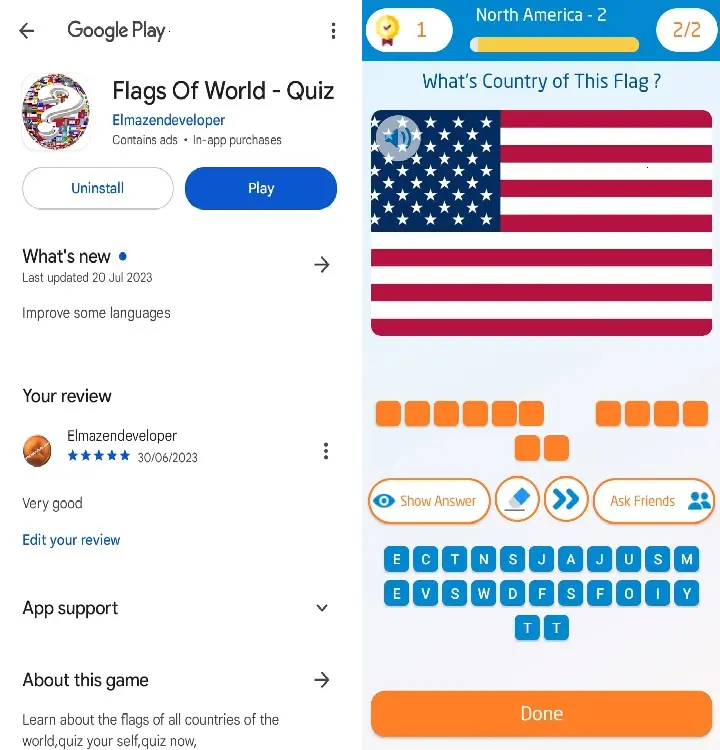
Download the application  Flags Of World - Quiz ,
Flags Of World - Quiz ,
And test your knowledge with Flags of World ,
1. Population of the United States
As of November 2024, the United States has a population of approximately **346,110 million people**, making it the third most populous country in the world, after China and India.
The population is characterized by incredible diversity, with people from various ethnic, cultural, and linguistic backgrounds contributing to the nation's dynamic identity.
---------------
2. The Meaning of the United States Flag
The flag of the United States, often called the "Stars and Stripes," consists of:
13 horizontal stripes: Representing the original 13 colonies that declared independence from Britain in 1776.
50 stars: Representing the 50 states that make up the country.
The colors also have symbolic meanings:
Red: symbolizes valor and bravery.
White: signifies purity and innocence.
Blue: represents vigilance, perseverance, and justice.
-------------
3. United States Currency
The official currency of the United States is the **United States Dollar (USD)**, symbolized by the "$".
It is one of the most widely used currencies in international trade and finance.
Coins and paper money are issued by the U.S. Treasury.
------------------
Flag of the United States

Download the application  Flags Of World - Quiz ,
Flags Of World - Quiz ,
And test your knowledge with Flags of World ,
4. United States Borders
The United States is bordered by:
Canada: to the north.
Mexico: to the south.
The Atlantic Ocean to the east.
The Pacific Ocean to the west.
In addition, the state of Alaska shares a maritime border with Russia across the Bering Strait.
------------------
5. The Culture of the United States
The culture of the United States is a blend of various influences, including Native American traditions, European, African heritage, and modern global elements.
Key aspects of U.S. culture include:
Diversity: The U.S. is a melting pot of cultures, religions, and languages.
Entertainment: Hollywood is the hub of the global film industry, and the country is known for its music genres like jazz, rock, hip-hop, and country.
Sports: Popular sports include American football, basketball, baseball, and soccer.
Holidays: Major celebrations include Independence Day (July 4th), Thanksgiving, and Christmas.
Cuisine: While hamburgers and hotdogs are iconic, the food scene is diverse, ranging from regional dishes like New England clam chowder to international cuisine.
-----------------
6. Best Places to Visit in the United States
The U.S. offers countless attractions for travelers.
Here are some of the most iconic destinations:
New York City, New York: Famous for landmarks like the Statue of Liberty, Times Square, and Central Park.
Grand Canyon, Arizona: A breathtaking natural wonder with stunning views and hiking opportunities.
Yellowstone National Park: The first national park in the world, known for geysers, wildlife, and scenic landscapes.
Los Angeles, California: Home to Hollywood, beaches, and cultural hotspots.
Las Vegas, Nevada: Renowned for its vibrant nightlife, casinos, and entertainment.
Washington, D.C.: The nation's capital, filled with historic landmarks like the White House and the Smithsonian museums.
Hawaii: Offers pristine beaches, and unique island culture.
-------------------
The United States is a country of contrasts and possibilities, with something for everyone to explore and enjoy.
Whether you're captivated by urban skylines, natural wonders, or cultural experiences, this nation has it all.
Flag of the United States

Download the application  Flags Of World - Quiz ,
Flags Of World - Quiz ,
And test your knowledge with Flags of World ,
- Details
- Written by: Elmazen
- Category: Flags of Countries of the World
- Hits: 704
Flag of Saint Vincent and the Grenadines
Flag of Saint Vincent and the Grenadines, Currency, Population, Borders, Tourist Places, Culture
Discover Saint Vincent and the Grenadines: A Caribbean Gem
Saint Vincent and the Grenadines is a captivating Caribbean nation known for its natural beauty, vibrant culture, and welcoming people.
Whether you're considering a visit or simply curious about this island paradise, here's an insightful guide to help you learn more about this stunning country.
Flag of Saint Vincent and the Grenadines
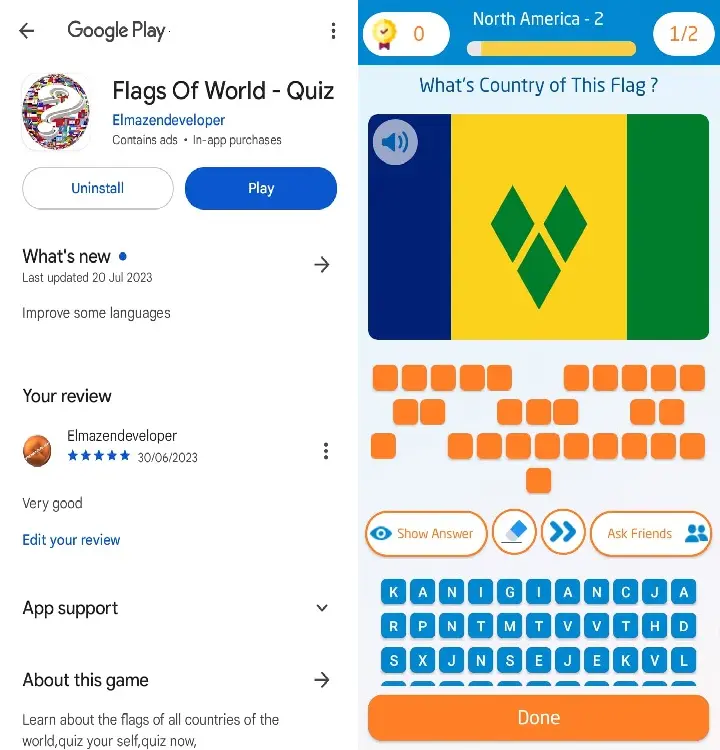
Download the application  Flags Of World - Quiz ,
Flags Of World - Quiz ,
And test your knowledge with Flags of World ,
1. Population of Saint Vincent and the Grenadines
As of the November 2024, Saint Vincent and the Grenadines has a population of approximately **100,000 people**.
The majority of the population resides on the main island of Saint Vincent, while the Grenadines - an archipelago of smaller islands - are more sparsely populated.
2. The National Flag and Its Meaning
The flag of Saint Vincent and the Grenadines features **three vertical bands** in blue, yellow, and green, with three green diamonds in the center of the yellow band.
Blue: symbolizes the sky and sea surrounding the islands.
Yellow: represents the warmth and sunshine.
Green: reflects the lush vegetation and fertility of the land.
The three green diamonds form a "V," symbolizing the country's nickname, the "Gems of the Antilles," and its location in the Caribbean.
3. Currency
The official currency of Saint Vincent and the Grenadines is the **Eastern Caribbean Dollar (XCD)**.
It is shared by several Caribbean nations and territories and is pegged to the US dollar at a rate of approximately 2.7 XCD to 1 USD.
Flag of Saint Vincent and the Grenadines

Download the application  Flags Of World - Quiz ,
Flags Of World - Quiz ,
And test your knowledge with Flags of World ,
4. Borders of Saint Vincent and the Grenadines
As an island nation, Saint Vincent and the Grenadines has **no land borders** with other countries.
It is surrounded by the Caribbean Sea and lies near Barbados to the east, Saint Lucia to the north, and Grenada to the south.
5. Culture
The culture of Saint Vincent and the Grenadines is a blend of African, European, and indigenous influences.
Music and Dance: Calypso, soca, and reggae dominate the music scene, with festivals such as Vincy Mas showcasing vibrant parades and live performances.
Cuisine: The local cuisine features seafood, breadfruit (a national staple), and spices like nutmeg and cloves.
Popular dishes include roasted breadfruit with fried jackfish and callaloo soup.
Language: English is the official language, but Vincentian Creole is widely spoken in informal settings.
Festivals: Carnival (Vincy Mas) and Nine Mornings (a unique Christmas celebration) are highlights of the cultural calendar.
6. Best Places to Visit
Saint Vincent and the Grenadines is a haven for nature lovers and adventurers.
Here are some must-visit spots:
a. Bequia
This charming island is known for its tranquil beaches, yacht-filled harbors, and vibrant marine life, making it a favorite among sailors and divers.
b. Tobago Cays
A marine park consisting of five uninhabited islands, Tobago Cays is a paradise for snorkeling, diving, and swimming with turtles.
c. La Soufrière Volcano
For the adventurous, a hike up this active volcano offers breathtaking views and an unforgettable experience.
d. Dark View Falls
These twin waterfalls on the island of Saint Vincent provide a serene escape surrounded by lush rainforest.
e. Kingstown
The capital city boasts architecture, bustling markets, and the historic Saint George’s Cathedral.
f. Mustique
This exclusive island is known for its luxury villas and celebrity visitors, offering a taste of the high life in a serene setting.
Saint Vincent and the Grenadines is a vibrant and diverse country that promises unforgettable experiences for anyone who visits.
Its stunning natural beauty, rich culture, and friendly people make it a true Caribbean gem.
Flag of Saint Vincent and the Grenadines
